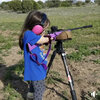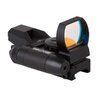@Dan Forrester - I apologize for writing a wall of text here, but please do read and consider the advice below. These rifles seem like a great idea up front, but really aren’t.
Having owned a several of these rifles in the past for use in beginner rifle classes and 1 on 1 instruction, I recommend you don’t waste your money on either. I made a group buy with a few other instructors in 2003 to end up with a half dozen of them, and I have bought onsie-twosie here and there over the years as student’s parents have bought rifles from or through me. I have wasted thousands of dollars on these rifles in the past, and would never do so again, so learn from my mistakes.
First: a 5yr old child will have around 8.5-9” length of pull, whereas these “mini” models like the Rascal, Crickett, and Henry Mini are 11.25”-11.5” (Crickett shorter than the other two). Most kids won’t truly grow to an 11.25-11.5” LOP until about 12yrs of age, at which point, it’s a failure of personal discipline if a 12yr old kid really needs to be handcuffed by a (poorly balanced) single shot rifle. Kids at that age also tend to grow fast enough that the rifle really doesn’t fit them well within a year or so. And what becomes of the rifle when the kid outgrows an undersized, under-featured single shot? It gets stuck in the back of the safe and the kid gets a new rifle, rather than continuing to grow memories and skills with the same rifle they’ve used for years.
Second: Probably most importantly, at its core, the entire premise of “start them on a single shot,” is a logical fallacy. Mechanisms might prevent the consequence of lacking discipline, but they do not actually promote responsibility or discipline. If a kid isn’t mentally mature enough to follow instruction or isn’t sufficiently disciplined to have appropriate trigger control, they’re not ready to shoot any rifle. The same lacking-discipline which would drive a child (or adult) to recklessly rapid fire a semi-auto will drive them to also pull the trigger on a poor sight picture or alignment, yielding poorer groups than they’d otherwise be capable. Teach a child the appropriate discipline and they will be able to manage any action (for example, I started my son on a semi-auto 22LR Marlin 60 when he was 2 years old, and my niece when she was 3 - and many other children from 4-5 yrs old).
Third: Most of these feature poor sights, poor triggers. And poor balance. Some have gotten better in recent years, incorporating accommodations for scope mounts, but many do not.
Fourth: they’re priced far too high for their features. These rifles are typically priced slightly below other standard models, but are featured far below the price point. For their limited utility and such short duration of actual fit to the child, it’s a poor investment.
The best advice I can give is to buy a bolt action or semiauto “Forever rifle” in a common model like a Marlin 60, Ruger 10/22, Savage Mark II, etc. Take-off stocks are available for $30-50, or aftermarket stocks are readily available (and I find kids LOVE picking their own rifle stock color, and do a better job of identifying with the rifle and carry better interest in practicing when they can personalize it). Cut one stock down now to 8.5-9” LOP, then replace it later with one 10-11.5” at 10-12yrs of age, and eventually, a full length stock (~13.5-13.65, typically). The rifle will retain utility throughout the child’s life, fully featured, rather than being outgrown so quickly and relatively discarded.






